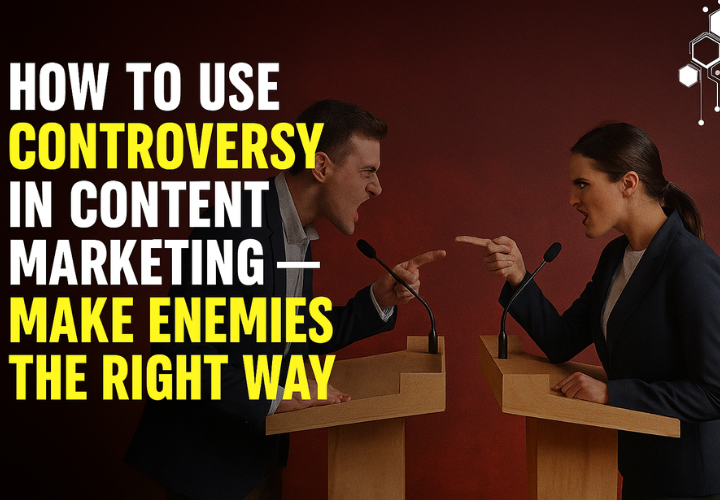How to Use Controversy in Content Marketing — Make Enemies the Right Way
Recently updated: September 15th, 2025
The vast majority of advice for content marketing is the same: write blog articles and case studies, make videos, and post them via social media. Yes, it works but in the current AI-driven environment of search every person is doing it.
If you’d like to have your content marketing company or brand be noticed, you’ll need something that is more precise. A product that can cut through the clutter.
This “something” is controversial.
Not cheap, clickbait-style controversy. Don’t make noise just to make noise. We’re talking about strategically provoking controversy -the kind that establishes your brand, draws the attention of others, and makes you famous while keeping your confidence intact.
Content marketing controversy is similar to eating salt. If you’re not careful, you’ll end up being boring. Too much and you’ll be burned. But get it right? You can create a conversation that is viral, earn public attention and have a brand voice that people cannot ignore..
The best part is that in the time of AI overviews and answer engines companies that adopt radical positions are likely to get mentioned or referenced in the top three results of Google as well as Bing.
How do you handle controversy to market your content properly? Let’s look at it in detail.
Why Controversy Works in Content Marketing

Controversy Creates Attention in a Noisy World
Our brains have the ability to be aware of conflicts. That’s the reason headlines include:
- “Why I’ll Never Use WordPress Again”
- “The Truth About Vegan Diets Nobody Talks About”
Get clicks quicker than “10 Best WordPress Plugins” or “Benefits of Vegan Diets.”
If everyone is playing the safe side an angle that is controversial can be a pattern interruption.
Example: When Tesla launched its Cybertruck it was a design that divided the world. It was either adored or opposed. However, the debate generated billions of dollars in free publicity.
Controversy Builds Tribal Loyalty
When you make a statement and make a statement, you will attract those who support your position — and deter people who don’t. This isn’t a problem. It’s actually how you can build tribe loyalty.
Examples: Apple vs. Microsoft in the 2000s. Apple ads mocked PCs in open fashion. Controversial? Yes. However, it also brought in the most fervent Apple supporters.
Controversy Fuels Algorithmic Amplification
Platforms for social media thrive on interaction. Nothing can drive shares, comments and debates as much as an opinion that is controversial. More engagement = more reach.
Example: Nike’s Colin Kaepernick campaign. The campaign sparked boycotts, outrage and huge support. However, it also increased Nike’s social participation up 1,400 percent in just 24 hours.
Controversy is AI-Friendly Content
Generative engines such ChatGPT Gemini and Perplexity give preference to distinctive, distinct perspectives when it comes to presenting reports. If your content takes a strong position, AI tools are more likely to give you a quote over more secure, generic competitors.
“The “Right Way” vs. “Wrong Way” to Use Controversy

There are many different kinds of controversy. Not all are all created to be. Here’s a quick framework:
| Wrong Way | Right Way |
|---|---|
| Offending groups for shock value | Challenging outdated industry norms |
| Clickbait with no real value | Backing claims with data and examples |
| Insensitive topics (race, religion, tragedy) | Business, industry, or consumer pain points |
| Fighting competitors directly | Taking a strong stand on customer issues |
Also Read: 10 Best Ways to Leverage Content Marketing for Startups
Framework: The 5-Step Strategy to Use Controversy in Content Marketing

Let’s look at how a content marketing firm can help clients using controversy in a way that is effective:
Step 1: Identify Safe but Polarizing Topics in Your Industry
Question: What do people discuss in my particular area?
- Financial: “Is crypto dead or the future?”
- Fitness: “Weights vs. cardio?”
- Marketing: “SEO is dead vs. SEO is evolving.”
Pro Tips: For more information, check Reddit, Twitter (X) and Quora threads. These are excellent sources of controversial topics.
Step 2: Pick a Side (and Commit to It)
What is the biggest mistake that brands make? They attempt to remain neutral. Neutral = forgettable.
An Example: Basecamp (the company that manages projects) has openly criticised Slack’s chat culture. Instead of playing safe they promoted themselves in the role of being “anti-Slack.” Bold, controversial and powerful.
Step 3: Confirm Your Controversy by supplying Data
Don’t just be a ranting idiot. Be sure to back it up by citing studies, stats or case studies. This is how you establish credibility.
Example: When Neil Patel said “Content is NOT king, marketing is,” it caused controversy. He backed his statement with evidence that proved the importance of distribution over the creation.
Step 4: Personalize the Controversy through Stories
People are able to remember stories, not statistics.
- Use customer stories.
- You can share your company’s values.
- Share a personal story of failure.
Example: Dove’s “Real Beauty” campaign challenged the beauty industry’s overly high standards. Yes, it’s controversial but told through real-life stories of people.
Step 5: To Channel The Attention Into Conversions
The media spotlights controversy however, you must turn that attention into sales leads.
Include CTAs such as “Disagree? Let’s talk. Book a strategy call.”
Create lead magnets based on your controversial position ( “Download our SEO Myth-Busting Guide”).
Brand Examples: Controversy Done Right in Content Marketing

Let’s examine how some major industries have utilized controversy to inform the strategy for their contents:
Nike: Taking a Political Stand
Nike’s “Believe in something. Even if that means giving up everything” campaign featuring Colin Kaepernick polarized the public. Some fans burned their Nike sneakers. However, Nike’s online sales rose 31% over three days.
Lesson: Bold is in line with the values of your brand to attract loyal customers even when they turn off other customers.
Tesla: Challenging the Auto Industry
If Elon Musk said, “Hydrogen fuel cells are stupid,” it was not impolite. But it also positioned Tesla as a leading authority on EVs. This stance was contrary to the norm, and influenced media coverage and increased brand recognition.
Lesson: Oppositional opinions can position your company as a thought-leader.
Burger King: Trolling McDonald’s
The Burger King’s “Moldy Whopper” campaign showed their burgers are rotting (unlike McDonald’s). Gross? Yes. Controversial? Absolutely. But it highlighted their no-artificial-preservatives message.
Lesson: Never be afraid of the discomfort that comes with it if it enhances your brand’s narrative.
Dove: Redefining Beauty
By challenging the beauty industry in general, Dove made itself synonymous with “real beauty.” Sales increased by $2.5B to $4 billion in just 10 years.
Lesson: Controversy is most effective when it is fighting for the customer and not against them.
Gymshark: Challenging Old Fitness Norms
Gymshark was a firm believer in body diversity and authentic fitness marketing. There were critics who criticized it, however, millions of young people were deeply connected.
Lesson: Make use of controversy to establish an understanding of the cultural context.
How Content Marketing Companies Should Apply This for Clients

If your company is in content marketing business Here’s how you can integrate controversy into a content strategy:
Blog Content:
- Examples: “Why Most Financial Advisors are Lying to You” (finance brand).
- Examples: “Why Cardio is Overrated for Fat Loss” (fitness brand).
Videos & Podcasts:
- Debate-style content.
- Hot-take YouTube videos.
Social Media:
- Twitter/X polls.
- Instagram carousels featuring headlines that contradict each other.
Email Marketing:
- Topic line: “The Biggest Lie in Digital Marketing (and What to Do Instead)”.
Lead Magnets:
- “The [Industry] Myths Report 2025.”
AI Overviews Optimization:
- Ask questions straight (“Is SEO dead?” It’s not, SEO is evolving. Here’s why…”).
- Provide structured, clear insights so generative engines surface your brand.
Actionable Tips for Using Controversy Without Burning Your Brand

Stay away from industries-related debate, not politics (unless your brand’s image is influenced by it).
- Always offer the solution when you make an unpopular claim.
- If backlash is growing, make adjustments to messaging fast.
- Start smaller (social posts) before launching the big (national campaigns).
- Training your team in emergency response in case of need.
Key Takeaways for Businesses
- Controversy draws attention in a busy world.
- It strengthens communities and weeds out the unqualified target audience.
- If it is done properly, When done right, when done correctly, it increases search engine optimization, AI visibility, and conversions.
- Brands such as Nike, Tesla, Dove along with Burger King have proven its efficacy.
- A Content marketing company can help you structure any controversy into strategic, safe storytelling.
Conclusion: Make Enemies the Right Way
It’s no longer just about mixing into. Search engines, AI tools and social media encourage the bold and differentiate.
If you’re looking to become the one that people will remember, you must be willing to take risks. It is important to choose your sides. You must be open to debate but be sure to do so with a strategy—just like how the best SEO services and SEO packages are built with precision and intent.
The Reality is:
In the event that you’re not making people uncomfortable,
It’s likely that you’re not making anyone take note of it.
The question isn’t “Should I use controversy in my content marketing?”
The most important question is: “Which controversy will I own to make my brand unforgettable?”
One thought on “How to Use Controversy in Content Marketing — Make Enemies the Right Way”
Leave a Reply
Latest posts by Vijaya Tyagi (see all)
Important Tips & Tactics to Boost Your Website Reputation!! - October 16, 2025
14 Years, Thousands of Campaigns, Countless Stories – And We’re Just Getting Started - September 29, 2025











After looking over a handful of the blog articles on your web page, I seriously appreciate your way of blogging. I book-marked it to my bookmark webpage list and will be checking back in the near future.